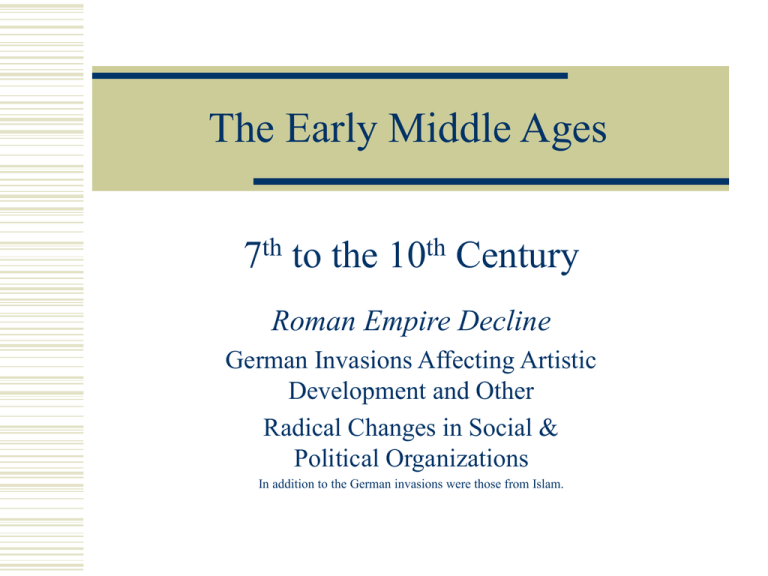Early Christian and Byzantine Art
advertisement

The Early Middle Ages 7th to the 10th Century Roman Empire Decline German Invasions Affecting Artistic Development and Other Radical Changes in Social & Political Organizations In addition to the German invasions were those from Islam. Islamic Art Idolatry forbidden Consisted mainly of abstracts, floral patterns, or other geometric objects Sculpture almost nonexistent Abundance of monumental architecture & architectural decorations Islamic Art Expressions Mosque: A place to pray and face towards Mecca Sahn: enclosed courtyard that all mosques have. Qibla: prayer wall Exterior: Tall minarets Large and elaborate Mihrab: small nitche to indicate the direction of Mecca. Hagia Sophia changed into a mosque Islam Islam means “submission to God’s will” Founded by the prophet Muhammed Message is “brotherhood of Man” & equality before God (Allah) Differs from Christianity No priesthood, no religious hierarchy, sacraments or requirements of literagy Does include rulers and leaders in prayer Islamic Instruction Faithfully conduct their daily lives Circumcise male infants Pray to Allah five times a day facing Mecca. Worship in the mosque on Fridays Give to the poor, Fast and practice abstinence in the daylight during Ramaden Allowed multiple wives The Great Mosque, Cordoba Mosque built in capital city Striking example of Islamic art Double arches first used here were duplicated in additions. (11.1,11.2, 11.3 & 11.4) Christians later turned this into a cathedral but it still conveys the original orientation of Islam. Northern European Art Influenced by the Germanic tribes New focus on artistic and political activities No monumental structure, paintings or sculpture was done to the constant invasions Invaders stimulated a new craft. . . Metalwork designs and techniques Anglo-Saxon Metalwork Purse cover from the 17th century. Found among a pagan ship wreckage treasures suggesting royalty Is of gold decoration; cloisonne enamel originally on ivory or bone & dark red garnets. Early Christian intelace designs and Near Eastern motifs SuttonHoo purse cover from East Anglia, England, 630 AD Merging animal forms suggest invasion Beowulf Earliest surviving European epic German folklore with strong Christian morality. A strange king child found adrift Denmark “Scyld Scefing” Famed was this Beowulf: far flew the boast of him, son of Scyld, in the Scandian lands. So becomes it a youth to quit him well with his father's friends, by fee and gift, that to aid him, aged, in after days, come warriors willing, should war draw nigh, liegemen loyal: by lauded deeds shall an earl have honor in every clan. Hiberno-Saxon Art Ireland escaped invasions at this time St. Patrick spread Christianity throughout Ireland and for years later it became a haven for scholars, missionaries, monasteries, . . Christian art also prevailed across Ireland. Style has been called Insular and Hiberno-Saxon (Hiberno is Latin for “Ireland”) Manuscript Illumination Illuminated manuscripts produced by monks in monasteries. Illustrated the Word of God; Visual pleasures Used a strict unity of color and form. Crisp, clear sometines contrasting colors; flat surfaces; patterning Lion Symbol of St. John, from the Book of Durrow, After AD650. Represents St. John, Evangelist as a lion . . . .later an eagle. Carolingian Period Book of Kells Corresponds with the crowning of Charles the Great-Roman empr. Charlemagne ruled over the Holy Roman Empire and surrounding territories and revived culture. Network of learning was created Latin manuscript texts. . .7LibArts 11.7 Tunc Crucifixerant XPI, from the Book of Kells (Matthew 27:38) Then they crucified Christ & with him two thieves Manuscripts Charlemagne’s rule involved the Roman revival of culture with manuscripts Manuscripts worked towards development of a practical form of portable artistic and educational communication They continued after Charlemagne’s death but more apocalyptic approach Flatter space, figures connected by geometric design rather than landscapes. Revelation & the Four Symbols of Evangelsits Revelation-last book of the New Testament Written by St. John John’s account of Christ’s word in his appearance to him. Visionary work with scripture, literary tradition and symbols: lion, bull, man, eagle. 11.8 Four Evangelists, from a Carolingian Gospel Book Lion: St. Mark; Bull: St. Luke; Man: St. Matthew, Eagle: St. John. Monasteries Each monastery: School Network for artists and scholars to communicate. Religious and Administrative Center for economic functions Communal living quarters for Monks Plans for monstery of St.Gall, Switzerland; plan placed church in the center; building around in order of importance of education Ottonian Period Charlemagne’s grandsons were ineffective rulers of the European reign & fell to invaders. After the Vikings takeover, the Saxons crowned Otto I as Otto the Great, emperor. Ottonian refers to rulers named Otto who worked to continue Charlemagne’s revival of Classical antiquity. Major Works of the Ottonian Period Ottonian refers to 3 rulers Otto(s) who stabilized Holy Roman Empire Architectural work: Benedictine abbey church of St. Michael’s Metalwork at Hildesheim by Bishop Bernward Originally an entrance Old and New Testament figures in high relief by thin, lively figures Bronze doors, St. Michael’s , Bishop Bernward (fig 11.13) Abbey Church of St. Michael’s (Fig.11.11) Chapter Summary & Important Information








